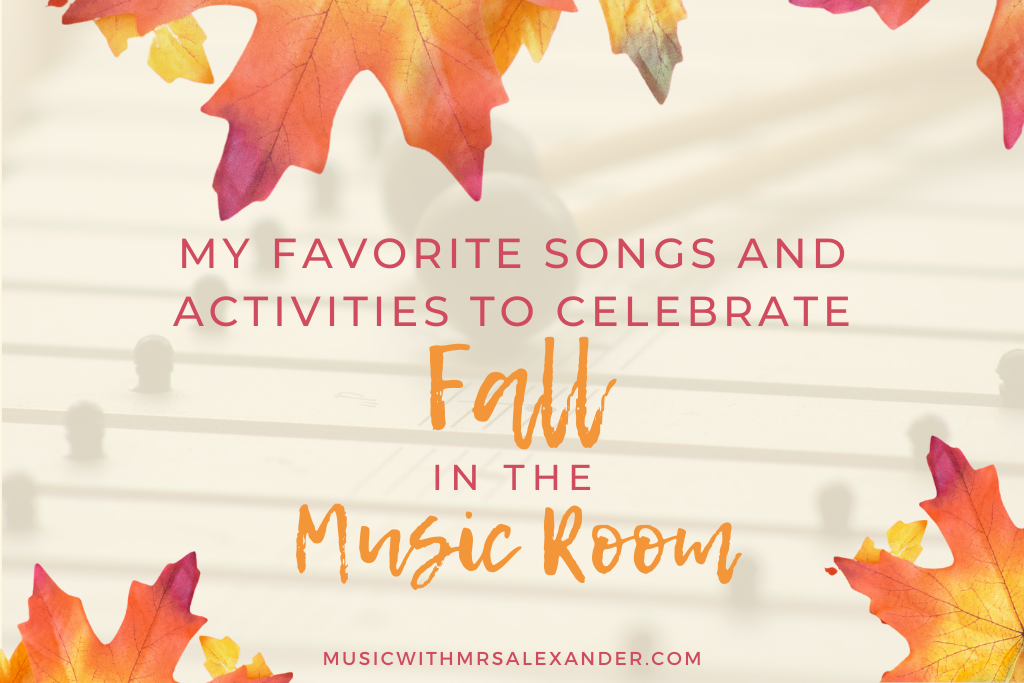
“But I think I love fall most of all…”
Fall is definitely my favorite season. Since I live in the south, we have stupid hot late springs and summers. Fall won’t show up until mid-October for us, but when it does, it’s heaven! Fall is a fun time in the music room as well. My students are finally in a routine and are pros at most of our routines and procedures. That means we can spend a lot more time on music making! Since fall is my favorite season, it’s no surprise that I sprinkle some autumn magic in my lesson plans. Here are some of my favorite games, songs, and activities that are perfect for adding to your fall music lessons.
Fall Songs for Elementary Music
Apple Tree
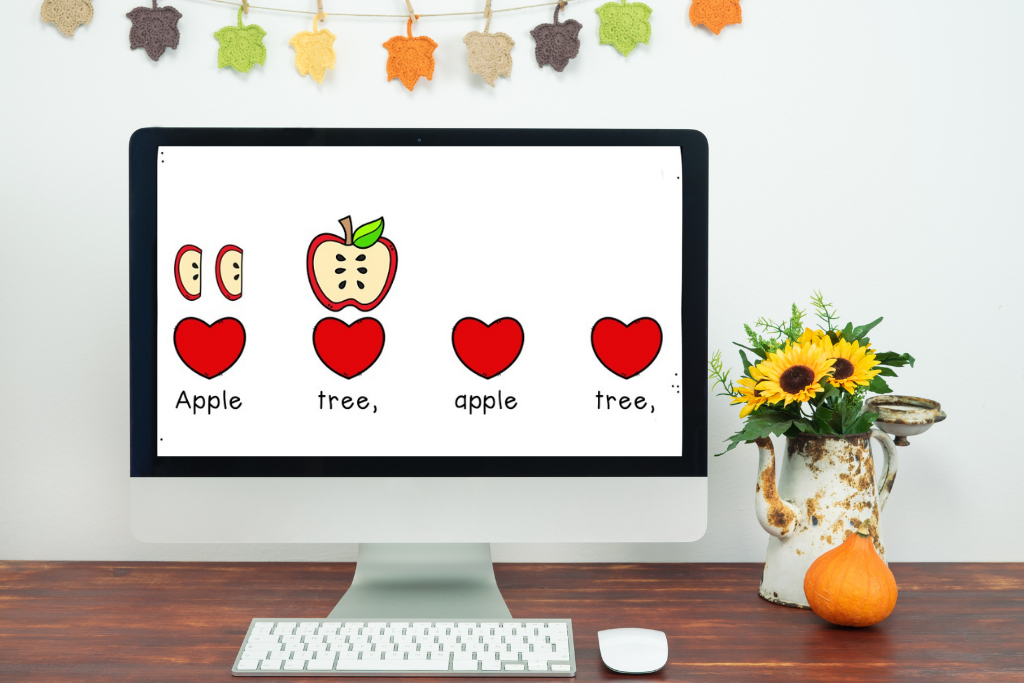
Apple Tree is a classic that my students beg for over and over. We typically start this song in the second or third week of school. In the first lesson, students learn the song and play the game. There are a few different variations, but this is how I play it. We make a circle, and two students create an arch with their arms (the “apple tree”). The class walks through the apple tree with their feet moving to the steady beat. On the word “out,” the arch comes down and traps a student (or students). They get added to the tree, and the game continues.
In week two, we learn all about rhythm. I use these song slides to decode the rhythm, using craft sticks and steady beat hearts. We start by using the beat tracking slides to sing and pat the steady beat. Then, we look at each line of the song and decode the rhythm. We say and clap the words on each beat, counting the number of claps (syllables). Once the entire line is done, we say the words and clap the rhythm. This lesson’s primary focus is on understanding the difference between beat and rhythm. It’s a tricky concept for my younger students, so I try to practice it often.

In weeks three and four, we learn about pitch and name our high and low pitches sol and mi. The first and third lines of the song use only sol and mi, so I show those to the class using iconic notation. We discuss why the apples are higher and lower, which leads to introducing/reviewing the word pitch. We search for it around the room and talk about how it means high and low. Then, we use these upcycled math manipulatives to create high and low patterns on a modified music staff. Once they have a grasp of high and low, I introduce the pitch names sol and mi. We use manipulatives to create melodies as a class, then I let them practice on their own using the Melody Maker station game.
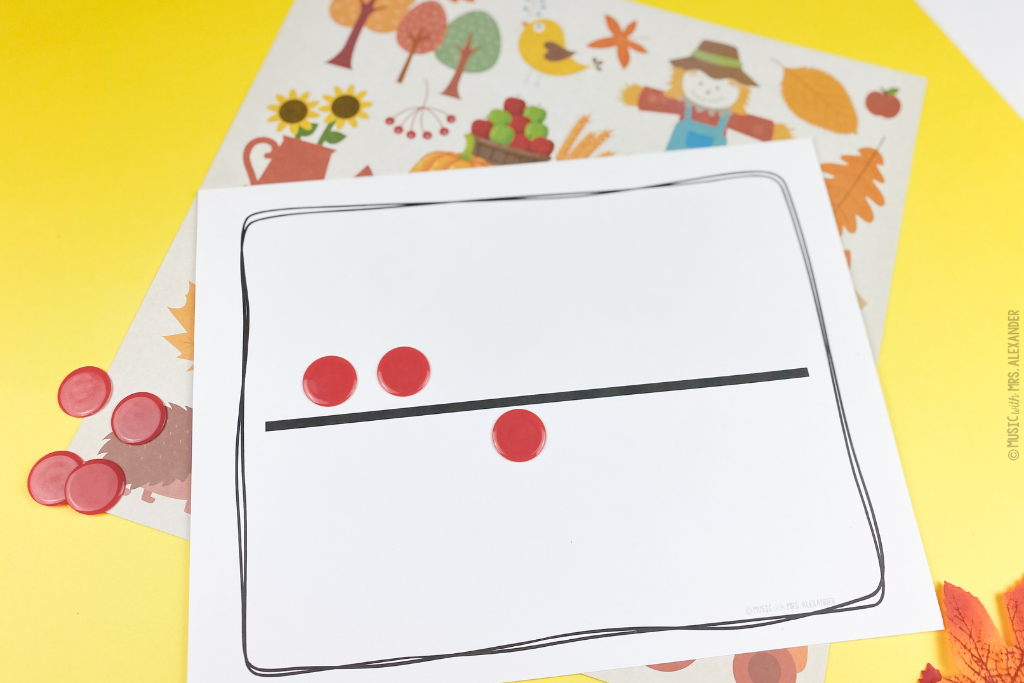
Who Has Seen the Wind?
Who Has Seen the Wind is a beautiful song with a minor melody. I love using it in my fall music lessons to prep half notes in second grade. It’s also great for practicing Orff instrument technique and learning how to independently play multi-part accompaniments. We start by learning the first verse of the song and adding one section of the accompaniment (the alternating half notes). Once they are able to play the accompaniment and sing confidently, I add the second accompaniment part on the glockenspiels. We rotate through all parts multiple times so that my students get many chances to play both parts. (Check out my instrument rotation setup here!)
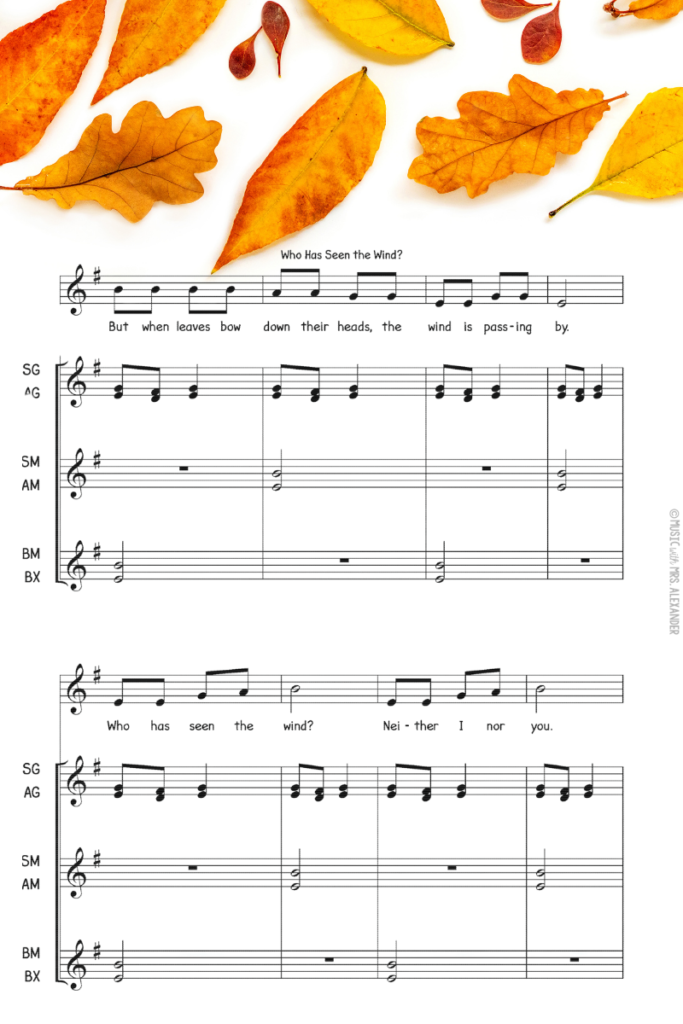
Fall Instrument Activities for Elementary Music
Leaves
Leaves from Exploring Orff has been my go-to for the past few years for introducing the Orff instruments to my first graders. It is also great for fall music lessons because I can connect it to the changing seasons and the falling leaves! I start this lesson by playing ascending and descending patterns on the piano. After demonstrating first, I ask my students to listen carefully and move their bodies to the music. We talk about how their bodies match the sounds they hear. When the music gets higher, their bodies get higher. Then, I sing the song, using my hands as the leaves. They copy me and make the connection to our warm-up activity: When my voice moves lower, their hands move lower.
After singing the song, we move to the xylophones. I set them up vertically instead of horizontally and call them our “trees.” We pretend to be squirrels climbing up the tree and leaves falling down the tree. Once we’ve practiced that for a bit, I have them turn the xylophones the correct way. I spend the remainder of the first lesson practicing moving higher and lower on the instruments while I sing the song.
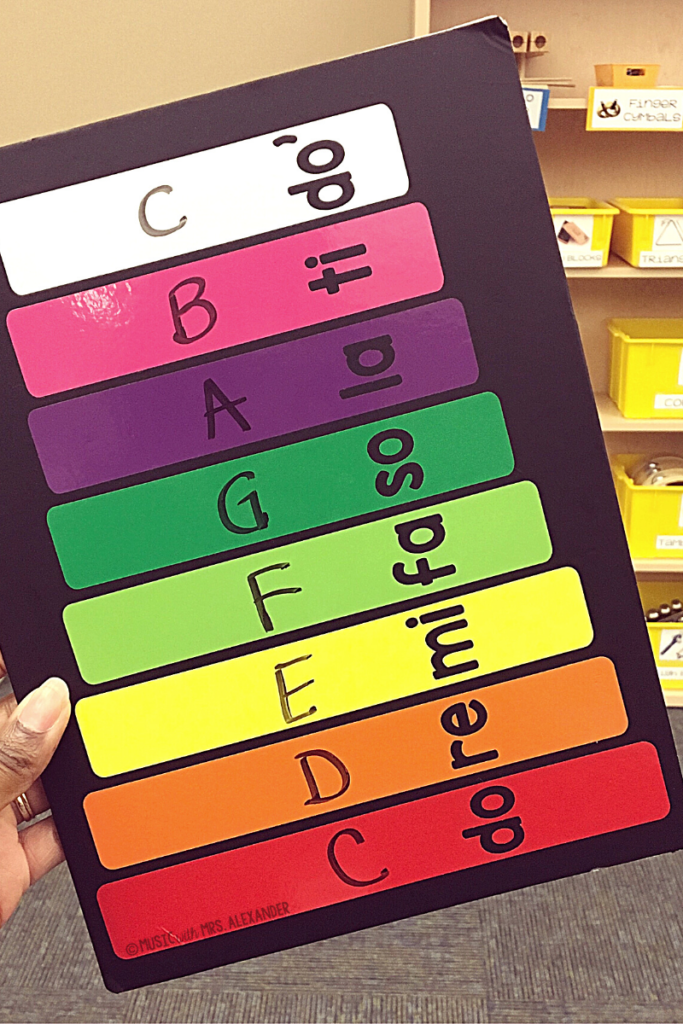
In lesson two, we review the song and which bars are higher and lower on the xylophones. When we move to the instruments, I teach them the melody of the song by having them start on high C and play each bar twice on the way down to low C. Eventually we listen to the song to decide where we only hear one sound instead of two–a nice little throwback to our rhythm decoding lessons! We end this lesson with half the class playing the melody and singing while the other half moves like leaves in the wind.
Pass the Pumpkin
Pass the Pumpkin is a song I use in my fall music lessons to practice steady beat with my second graders. In the first lesson, I teach them the song by rote. Once they are comfortable with the song, we pat the steady beat on our laps while singing, then we play the game. Here’s how I play it:
- The students make a circle and pass a stuffed pumpkin to the steady beat.
- On the last word (BOO!), the person holding the pumpkin is out. They move to an instrument to play the steady beat.
- Play continues until only one person is left
In the second lesson, we learn an instrumental accompaniment to the song. I found this one online as a slide share. I set up the instruments in four stations with enough instruments for the entire class. We play the accompaniment and rotate through each station at least twice.
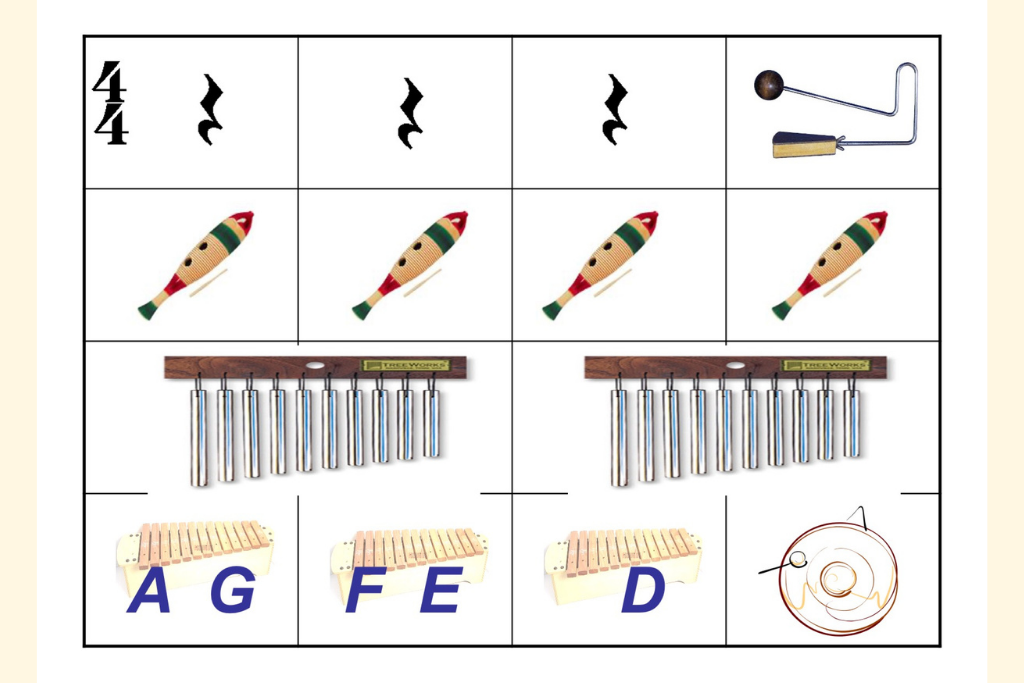
Fall Music Games and Stations
Fall Leaves Melody Match
This stick-to-staff matching game is a perfect addition to your fall music lessons to practice reading melodies from the music staff. Each leaf is split in two–the melody (on the music staff) is on one half, and the stick notation of the melody is on the other. For my younger students, we use the leaves as a melody scavenger hunt. I put several of the stick notation halves around the music room. Then, they work with a partner or a team to search for their matching half. Once they think they have a match, I scan the QR code on the leaf and have them check it. I use my AppleTV to AirPlay my iPad screen on my smartboard so that everyone can see without crowding around my iPad screen! Once everyone has found a match, we shuffle the leaf halves and play again.
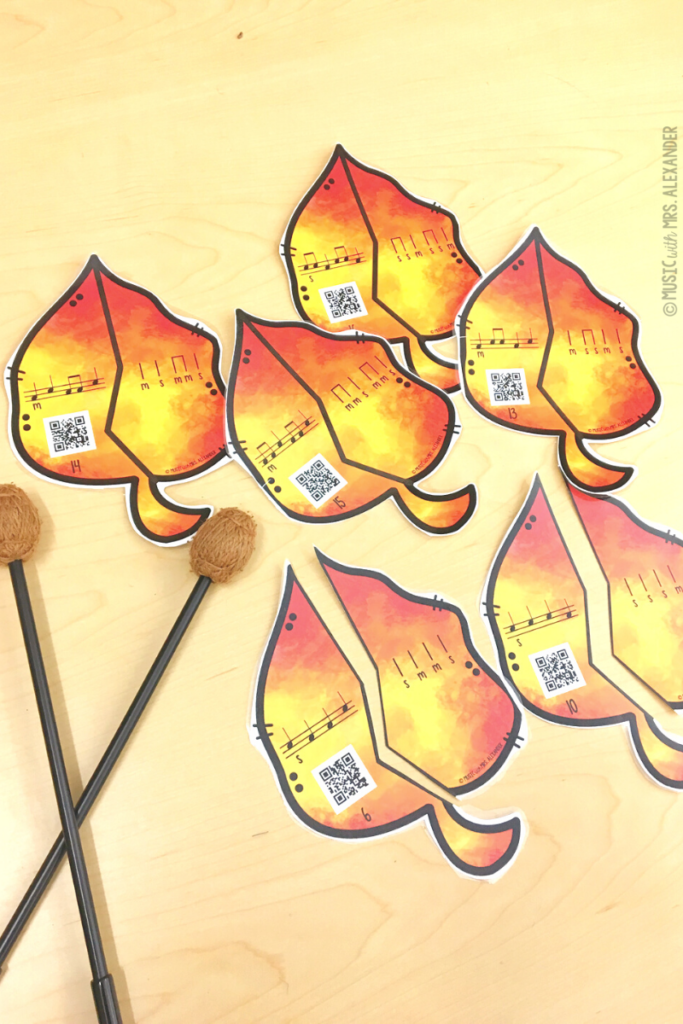
Another way I’ve used this game with my older students is by giving each student a leaf half. They have to find the person who has their matching half. Once they have a match, they come to me to scan their QR code. If they are correct, they sit with their partner while the rest of the class keeps searching. After everyone has found their matching melody, we shuffle the leaf halves and play again. They love to have me time how long it takes for everyone to get matched up! It’s like a game of Beat the Clock tied in with melody review!
I’ve also used this activity as a small group station. Each group gets a bag with 12 halves, six melodies total. They work as a team to match their leaves, then they scan the QR code with an iPad to check their answers. Once they are done with one set, they bring their bag to me to switch out for another. Working through all the sets typically takes the entire class period, making this a great activity for a fall game day in the music room!
I hope this post has given you a few ideas for fall activities in your elementary music classroom. Planning for fall…or winter or spring? Need help creating a sequential plan for your music curriculum? Check out this post to learn more, and click here to download a free K-2 scope and sequence for the entire year!






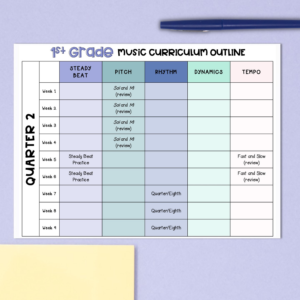
One Response